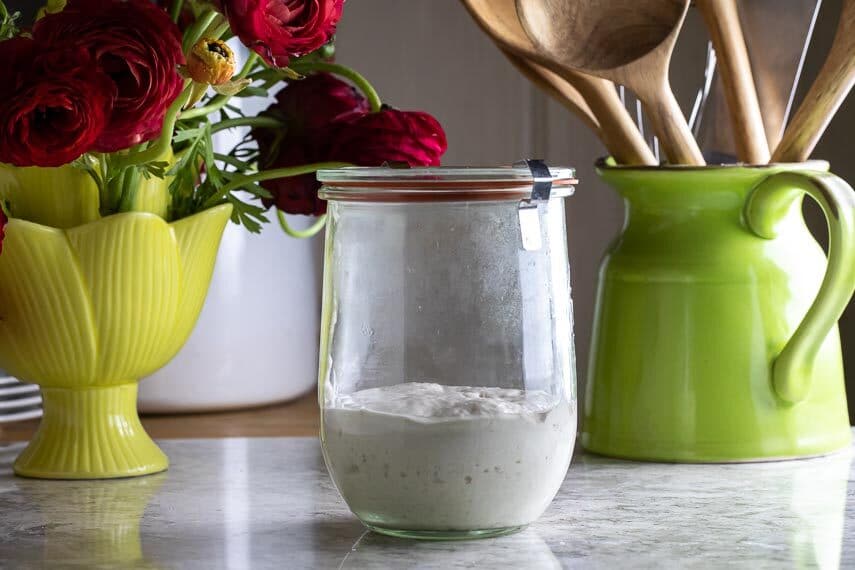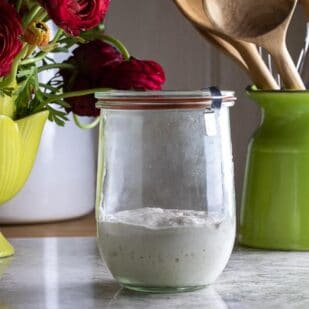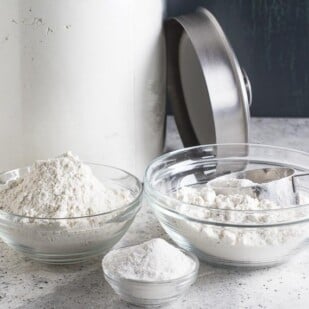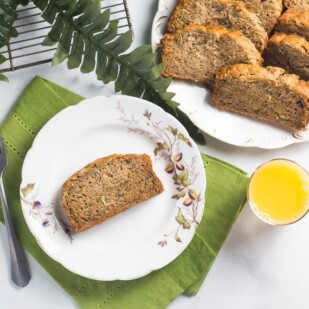Our Low FODMAP Sourdough Starter is a basic sourdough starter. The fructans present in wheat are reduced during the fermentation process, which is what makes resulting sourdough bread lower in fructans. Fructans are part of the “O” (or oligosaccharides) in the FODMAP acronym.

How Is This Sourdough Starter Different?
This sourdough starter is a conventional sourdough starter using wheat flour and water. If you have a process you already use to create a sourdough starter, then by all means stick with it and you can make our Low FODMAP Sourdough Pizza sooner rather than later.
If you need to make a starter, why not use our recipe, below?
There is no one absolute way to create an active sourdough starter; our approach is quite conventional and will get you started on your sourdough journey.
Please do not write us and ask if you can tweak this or that step. Because the answer is always going to be, yes you can, but that’s not what we are doing here. Either follow this recipe or follow your own.
Low FODMAP, Not No FODMAP
Any bread or pizza made with this starter will be lower in FODMAPs. Remember, the diet is low FODMAP, not no FODMAP. Unless a sourdough bread (pizza, waffle, etc.) is lab tested for FODMAPs, one can never know for sure what the precise FODMAP level is. Please eat to your tolerances.
The only way to determine whether you can digest our sourdough pizza, or other sourdough baked goods, without triggering symptoms is to try it.
Please try when you are stable and in your Challenge Phase to be cautious. Or try a very small serving during Elimination
Please review our articles:
- What is A Low FODMAP Serving Size?
- What To Do If A Food Has Not Been Lab Tested
- How To Choose Low FODMAP Bread
- How Fermentation Affects Sourdough Bread & Dairy
- Ask The Right Question: Is This Low FODMAP vs. Can I Tolerate This?
- And read this study on how fermentation lowers fructans.
While not a true sourdough, you might also be interested in our 72-Hour Ferment Pizza Dough and our Wood-Fired Neapolitan-Style Pizza, which also has a 72-hour fermented pizza dough.
No, our sourdough starter is not gluten-free, and it doesn’t need to be. Please review our article, The Low FODMAP Diet Is Not A Gluten-Free Diet.
We think a scale makes this – and so many other recipes – much easier to make. We highly recommend investing in a digital scale. You will see from the process described below that a scale makes quick work of all the various steps.
We suggest you get two kinds of flour. We like to begin with organic whole wheat flour on day 1, then switch to organic white wheat bread flour.
The extra sourdough-friendly microorganisms in the whole wheat gives the starter extra oomph at the beginning. Then we like continuing with white bread flour as that creates a basic and versatile sourdough starter.
Water plays a huge role in sourdough starter, which is simply a combination of flour and water.
If your water is heavily chlorinated, measure it out and let it sit out overnight. Chlorine not only affects flavor, but it negatively affects yeasts as well.
Tap water is usually fine. If you have carbon filters or a reverse osmosis filter system, then you are good to go.
If you are in doubt, use bottled water, but not heavily mineralized water.
My tap water is heavily mineralized, and I cannot successfully make sourdough starter with it, so I use bottled.
You will see various ranges recommended but about 70°F to 80°F (21C to 27°C) is considered an optimum room temperature range for developing your sourdough starter.
In cooler room temperatures the starter will take longer to become active, and you will need more time between feedings. The starter will be more active at warmer room temperatures and you will need to feed it more often.
If anything, we hear more people complain of rooms that are too cool, rather than too warm. Try placing your starter on top of your water heater, refrigerator, or any other appliance that might generate some gentle heat. A turned-off oven, with the light turned on, can work well.
If you will be making a lot of sourdough and/or yeast risen baked goods, then consider investing in a temperature-controlled proofing box or heating element.
The temperatures at which your sourdough develops not only affects how quickly or slowly it becomes active, but it also affects how the yeasts and bacteria consume the sugars (present in the flour and other ingredients) and in which proportions. This also not only affects flavor – it also affects acidity, which in turn is associated with FODMAPs.
Sourdough Bread Acidity & FODMAPs
In an article from the International Journal of Food Sciences and Nutrition titled “Reducing FODMAPs and improving bread quality using type II sourdough with selected starter cultures” we have learned quite a bit about the relationship between sourdough culture, baker’s yeast, acidity and FODMAP levels, including fructans, as well as sorbitol and mannitol.
Why Does Sourdough Bread Taste Sour?
Sourdough is an active culture of lactic acid bacteria and yeast in a mixture of flour and water. Yeast produces gas – carbon dioxide – which provides the leavening action in your sourdough pizza and breads. The lactic acid bacteria produce lactic acid, which creates the sour flavor we associate and expect from sourdough baked goods.
Acidity, Sourdough & FODMAPs
Sourness is literal acidity and is measured by the pH scale.
The pH scale ranges from 0 to 14, with 7 being neutral. pH values less than 7 are acidic, while pH values greater than 7 are alkaline, also referred to as “basic”.
In the article linked above, and again here, we learned that the actual acidity in sourdough starter and resulting breads is related to FODMAP reductions. The breads with higher acidity had lowered fructans.
Does this mean if a sourdough baked good tastes really sour that we can know it has a greater reduction of fructans? We cannot know for sure, especially since sour flavor in baked goods can be created with the addition of vinegar, citric acid or other ingredients meant to accentuate sour flavor, which have nothing to do with FODMAP reduction.
If you make your own sourdough starter and bread or pizza and it tastes really sour – and you have control over the ingredients – we still cannot know for sure.
As always, unless a product is lab tested, we do not know its FODMAP content, although we do know that FODMAPs are reduced in sourdough products. We just don’t know how much they are reduced.
How Do I Know When To Feed My Sourdough Starter?
Here is the deal. There is a schedule that all sourdough starter recipes suggest, but it is really just a guideline. As we have explained, the development of the starter will largely depend on the temperatures to which it is exposed.
You want to feed the starter when it is hungry. It is better to slightly underfeed than overfeed.
A hungry starter shows activity, which comes in the form of bubbles (gas formation) as well as distinct, and sometimes dramatic, rising and falling. You can tell if it has risen and fallen by looking at the sides of your jar. If it has fallen there will be a line above the starter where it rose to, before it deflated and fell back to its present level. This can be a small amount or even a doubling in height, or more.
Many sourdough experts will recommend that you watch the jar, not the calendar. Some folks have told us it takes 3 full weeks for their starter to be ready. If you have a cold temperature in the room where your starter is living, this very well might be the case.
How Long Does It Take To Make Sourdough Starter?
It can vary, as explained above, but assume at least 1 full week. It will largely depend on the temperature of your room and how quickly or slowly you get activity in your starter. You will be attending to your starter every day, but each day will be less than 5 minutes of work.
Can Discarded Starter Be Used?
Many folks hate the idea of discarding all that starter during feedings as it feels wasteful. I am not going to develop recipes using discard, as the discard is not usually incorporated into a recipe that is then fermented further for any appreciable length of time, which would be when the fructan lowering occurs.
If you really want to try using your discard and understand the FODMAP stakes, King Arthur Flour has a great guide.
FODMAP Information
Our recipes are based on Monash University and FODMAP Friendly science.
- Wheat Flour: The low FODMAP diet is neither wheat-free nor gluten-free. Small amounts of wheat are low FODMAP. For instance, 35 g of wheat bread made with white wheat flour – about 1 slice – has been lab tested by Monash University and is deemed low FODMAP.
Please always refer to the Monash University & FODMAP Friendly smartphone apps for the most up-to-date lab tested information. As always, your tolerance is what counts; please eat accordingly. The ultimate goal of the low FODMAP diet is to eat as broadly as possible, without triggering symptoms, for the healthiest microbiome.

Low FODMAP Sourdough Starter
Our Low FODMAP Sourdough Starter is a basic sourdough starter. The fructans present in wheat are reduced during the fermentation process, which is what makes resulting sourdough bread lower in fructans. Fructans are part of the “O” (or oligosaccharides) in the FODMAP acronym.
Low FODMAP Serving Size Info: Please note that it is impossible to determine a serving size from starter, but search engines like Google want to see "serving size". The serving size of 36 is arbitrary and only somewhat based upon how much bread could be baked, and what the serving size might be of the finished product.
Ingredients:
- 120 g organic whole wheat flour
- Water: cool if your ambient room temperature is hot; room temperature or warm if your ambient room temperature is cold
- Organic white wheat bread flour
- 1- liter or 1-quart non-reactive container or jars with lids
Preparation:
-
Day 1: Measure out 120 g of the organic whole wheat flour and place in a clean glass, plastic or other non-reactive container; we use glass jars with at least 1-liter or 1-quart capacity. Slowly stir in 120 g of water (about ½ cup) until the flour is well saturated. The mixture will be thick but should be smooth, sort of like peanut butter. You can add a tiny bit more water if you need to. Place the cover on top, but do not twist it down tight or clip it down (with the Weck jars). Place somewhere warm for 24-hours. The ambient temperature of your room will dictate how quickly or slowly your sourdough starter development unfolds.
-
Day 2: After 24-hours, check your starter. There might not be any activity (bubbling) at all. Some starter directions have you wait another day if there is no activity; others (such as King Arthur Flour) say to go ahead and feed it, which is what I do. Measure out 120 g of starter and discard the rest. To the reserved 120 g of starter, first stir in 120 g of water, then stir in 120 g of white bread flour. Cover, but not tightly, and allow to sit for 24 hours.
-
Day 3: By now some activity should be present. You are about to begin feeding it two times a day, evenly spaced out. If you can do it 12 hours apart, that is perfect. By now you should know the drill: Measure out 120 g of starter and discard the rest. To the reserved 120 g of starter stir in 120 g of water, then 120 g of white bread flour. Cover, but not tightly, and allow to sit for 12 hours, then repeat. Let sit overnight.
-
Day 4: Repeat Day 3 directions.
-
Day 5: Repeat Day 3 directions. By this day, best case scenario, your starter should have at least doubled in volume. There should be lots of bubbles as well as a pleasing, tangy aroma — pleasingly acidic, but not overpowering.
-
Day 6: Repeat Day 3 directions, again looking for all the visual cues for activity.
-
Day 7: Repeat Day 3 directions again, but this time after the last feeding, seal the top up tightly and transfer to refrigerator. Now going forward, feed the starter once a week, weighing out 120 g of starter, discarding the rest, and stirring in 120 g of water and 120 g of white wheat bread flour to the reserved 120 g of starter. Re-seal and refrigerate until needed. Keep feeding weekly.
-
On the day you are going to use it, remove the amount you need for your recipe, making sure you have 120 g leftover to feed, store and keep for next time. If you need so much starter that you do not have enough leftover, feed it a couple of times without discarding until you are back to where you need to be.
-
Store in the refrigerator and feed and water once a week.
Notes:
FODMAP Information
Our recipes are based on Monash University and FODMAP Friendly science.
- Wheat Flour: The low FODMAP diet is neither wheat-free nor gluten-free. Small amounts of wheat are low FODMAP. For instance, 35 g of wheat bread made with white wheat flour – about 1 slice – has been lab tested by Monash University and is deemed low FODMAP.
Please always refer to the Monash University & FODMAP Friendly smartphone apps for the most up-to-date lab tested information. As always, your tolerance is what counts; please eat accordingly. The ultimate goal of the low FODMAP diet is to eat as broadly as possible, without triggering symptoms, for the healthiest microbiome.
Nutrition
All nutritional information is based on third-party calculations and should be considered estimates. Actual nutritional content will vary with brands used, measuring methods, portion sizes and more. For a more detailed explanation, please read our article Understanding The Nutrition Panel Within Our Recipes.








I would like to make this starter. I do have several questions;
Where can I get organic white wheat bread flour?
Can I make this sourdough bread in a bread machine?
Can I create more starter from the discarded starter and have several batches?
Thanks!
Hi we are fans of King Arthur flour. I am not sure which bread you are referring to because as of this moment we only have our pizza dough recipe. We do not have any recipes that we have tested in a bread machine. You could try creating several starter batches.